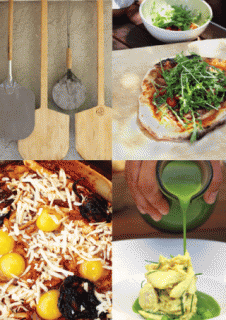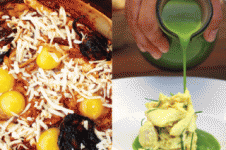
For Western Living Magazine
Napa wines, we all know already: super-cabs and fruit bomb pinots, rich chardonnays and saugnvinon blancs bright with citrus. But food in Napa is becoming as rich a story. So, on a recent tour around the valley with chefs Barbara Alexander and Adam Busby, it seemed impossible to stop the car without encountering some exquisite barotta cheese or strawberries so pungent we could smell them before opening the car door or, for that matter, wild asparagus and fennel growing rampant along the roadside.
Of course, hanging out with Alexander and Busby – whose surnames, surely, seem predestined to brand something known throughout the western world – this is the kind of thing you might expect. Two of British Columbia’s brightest culinary exports, Busby is the former Executive Chef of Bishops, then Chef/Co-Owner at Star Anise during its first ascendency in Vancouver in the mid-90s, while Alexander apprenticed at the Pan-Pacific before going on to guide the legendary Paramount Restaurant in Sydney to accolades including ‘Best Restaurant in the South Pacific’. They met as instructors at Dubrulle’s Culinary Institute in Vancouver, moving together to work as Chef Instructors at the Culinary Institute of America Greystone, the Napa outpost of the most prestigious culinary school in North America, some would say the world. The two are now a power-foodie-couple in Napa, with Alexander having moved on to the Napa Valley Cooking School, where she is Executive Chef and Director of Culinary Operations, while Busby has assumed the senior position of Director of Education at the CIA.
My wife and I, and our son, would have happily gone to visit Alexander and Busby, and their daughter Eva, just for the pleasure of having chefs make us dinner in their home. But seeing them in their respective workplaces was also revealing. No matter how good you get as a home cook, after all, there are always moments dealing with long time cooks that serve to illuminate what is only possible with years of experience and insider knowledge.
In Busby’s case, this is clear just walking with him around the off-limits back areas of the CIA Greystone, the impressive stone structure of which used to house a monastery, then a winery. There is something clandestine about these spaces, the sense of trade secrets. Here you have 17,000 square feet of kitchen with massive banks of gas and induction ranges, a wine appreciation center with a pressurized air system to keep out external smells, and then the Flavor Discovery Center where food companies can test products in a kitchen wired up by cameras and other feed back loops to tasting tables in a mock dining room.
Busby, who is one of only 61 Certified Master Chefs in North America, is in charge of every element of the students’ education here, and giving the tour he gave off the calm emanations of the deeply trained. Having toured us around the CIA’s “edible landscape”, where virtually everything in sight can and will become an ingredient, Busby carried on in casual conversation to discuss phylloxera vine fungus, olive oil, tandoori oven construction, and the possibility of hidden cellars of wine in the 13 unexplored tunnels behind CIA Greystone that collapsed during the Loma Prieta quake of 1989.
Over at the Napa Valley Cooking School meanwhile, we drop in on Alexander in the middle of a 75-cover lunch service put on by her students. Alexander plunks us down without fuss at a table in the kitchen to feed us the most exquisite lunch we’d eaten in years. Eight courses, including chilled pea soup with delicate trace flavors of cardamom, a seared scallop with crispy shallots and a raison caper sauce, and a brilliant lamb loin with mint yoghurt and a Morrocan spiced green harissa. All of this accompanied by a rich cabernet sauvignon from Pride Mountain.
“Someone actually emailed me and said they thought we did a better lunch here than at the French Laundry,” Alexander told us, coming over for a quick hello in the middle of service. Then she laughed. “I don’t know about that, although we’re probably busier than the French Laundry.”
At home, you might think super-pros like this would eat as if they were still at a restaurant. But even though they make sure to cook for each other every night, the house style at Alexander and Busby’s immaculately restored 1950s bungalow in the hills not far from Angwin is altogether more natural and unaffected. This attitude is something you sense the second you enter their backyard, with the hand-built clay oven based on an Alan Scott design, the low planters full of radishes and micro-basil, herbs and heirloom tomatoes, and then the heritage breed chickens all squawking around the coop down at the bottom off the garden.
“Yeah, chickens are kind of “in” right now,” Busby says apologetically, but then explains that they were the missing link in the holistic home-gardening cycle they were trying to create here. “The chickens produce the nitrogen-hot manure that goes into the compost that goes into the garden that makes the vegetable scraps that we feed back to the chickens.”
To which Alexander adds: “Plus, you have to try these eggs. They’re like nothing you’ve ever tasted.”
Dinner our first night is a quick one, because we’re planning a bigger feed the next day. But still the special blend of unpretentious taste and high-end technical skill come to bear. We eat fish tacos, the recipe for which comes from an old friend whose family has run a restaurant in the Baja for years. As with everything we will eat this weekend, the fish tacos are the product of serious expertise: the fish shallow-fried perfectly in a pan carefully monitored with an oil thermometer. And yet, the product of a casual insider’s knowledge too. Cabbages and radishes, not lettuce in the tacos. Crème fraiche not sour cream. And, naturally, a dash of French’s mustard in the batter because that’s just how it’s done.
If there were a supreme illustration of the Alexander/Busby ouvre though, we are surely treated to it the following day. After much foodie trolling through the streets of St Helena and Napa, we settle on a piece of Tamworth wild boar belly from a spectacular butcher called Fatted Calf. Watching two cooks of this caliber prepare such a humble cut is an education in itself. Simplicity and smarts, it seems to me. The belly is rubbed with herbs and garlic, and then simply folded on top of a pan of quartered onions, before being roasted in the outside oven for several hours at a controlled 300 degrees. The belly is then sliced thinly and served on top of a bread salad, tossed with arugula and a dressing made with balsamic vinegar and the pan drippings.
Perfection. And indescribably light, given it’s a slab of wild pig with crackling that we’re eating.
While the kids play in the garden, we sip a bottle of Viader DARE cabernet franc and listen to Busby’s harrowing tales of how he earned the extremely rare Certified Master Chef designation (which, despite the 85% fail rate, might well have been Alexander’s too if she hadn’t had the minor distraction of having a baby during their training). Describing the ordeal – which involved cooking 24-7 for 10 days in front of other Certified Master Chefs, making everything from perfect consomme to dishes nobody has seen since Escoffier – Busby says: “There were guys that came with sous-chefs, with special knife racks, with drugs to keep them awake.”
Long pause. Then: “I just brought my knives and a picture of Barb and Eva to put up at my station. That’s it.”
And as if to punctuate the notion, Alexander sends us home with three eggs from the chickens out back and a ramekin of fleur de sel (just in case the insanely luxurious Calistoga Ranch doesn’t have any). We eat the eggs the next morning, looking down into the quiet ravine behind our cabana. A perfectly natural and unaffected breakfast. And a reminder of how the real pros do it.

